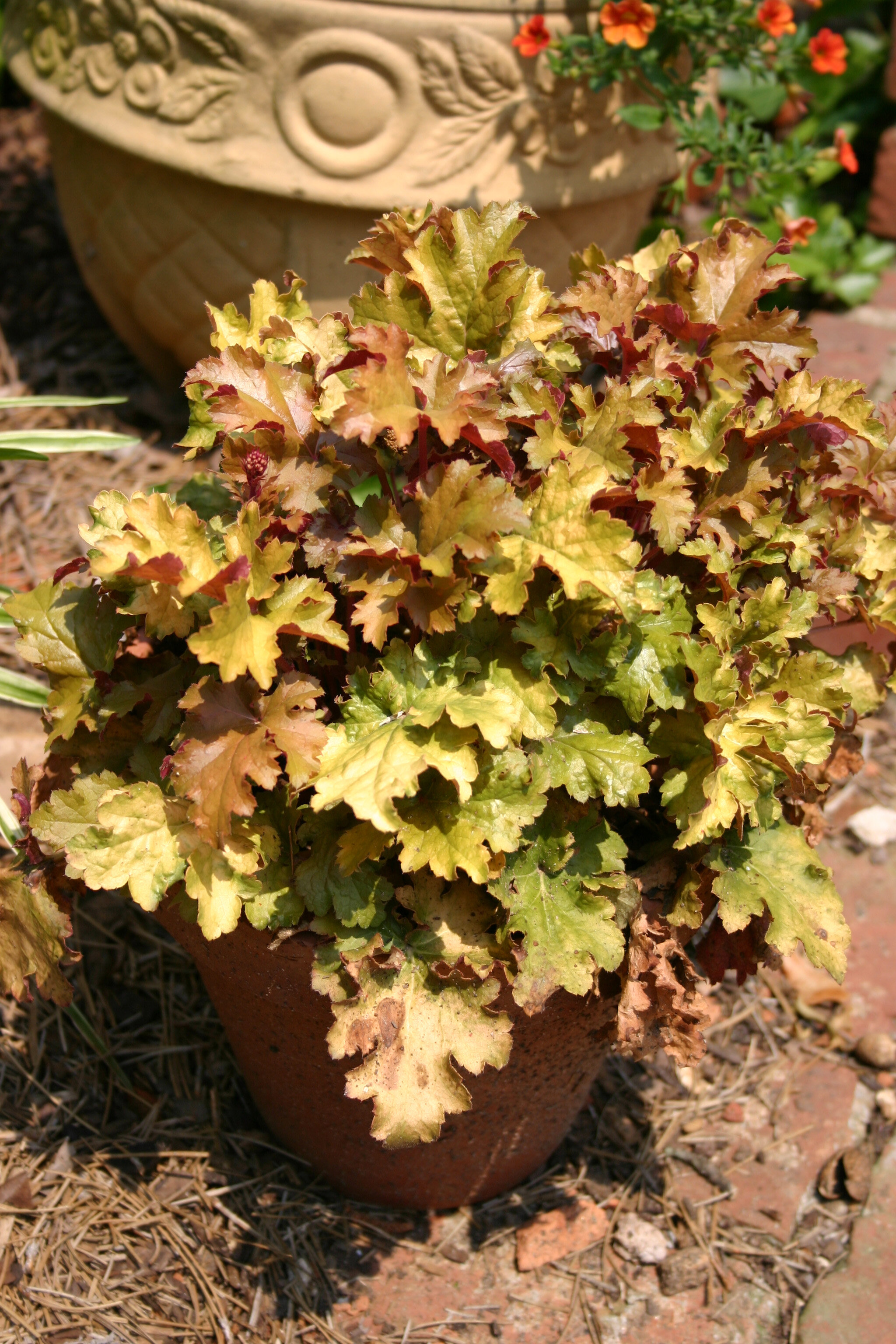When the winter garden is clothed in dormant twigs and fallen leaves, a touch of lively color lifts the spirit and reminds us that spring lurks ahead. Heuchera is a colorful group of perennials that are hardy from zones 4 to 9, depending upon variety and lineage. Modern cultivars have parents in H. villosa and H. americana. In the south, Heucheras (common names: Coral Bell, Alumroot) withstand hot and cold temperatures and look good every month of the year. Tiny blooms, a favorite of butterflies, are held atop wiry stems, but Heucheras are grown for their outstanding foliage. Cultivars have caramel, rose, lime, purple or green leaves marked with silver, red or white.
The lovely chartreuse green ‘Citronelle’ is one of the most heat tolerant cultivars. Grow it in shade to partial shade, where the leaves will be more yellow than green. Full sun leads to crispy edges and bleached leaves. I planted dozens of these in a lightly shaded bed. Within three years, there was only a single survivor. Each one got smaller and smaller, dwindling down to a single leaf before disappearing completely. I finally discovered the key to success – well-drained soil. The native heavy clay soil of upstate South Carolina mandated container culture, enhanced by fertile, well-drained potting soil and frequent watering. I plucked the lone ‘Citronelle’ specimen from the ground and placed it in a container with two other Heucheras, a purple-leaf variety (lost the cultivar name) and ‘Caramel,’ with caramel-colored leaves. Instant success! I eventually moved ‘Citronelle’ to her own container and replaced her with ‘Key Lime Rickey.’ These three live shoulder-to-shoulder in a container which looks as good in February as in August. Two ‘Amber Waves’ plants look especially good in a pair of peachy-toned clay pots along a brick walkway. These are sited in full sun. (Evidently, they did not receive the notification that they were meant for shade.)
A trio of Heucheras (‘Caramel,’ ‘Key Lime Rickey,’ and an unidentified purple leaf cultivar). These three live in harmony all year long. The container looks this good even in winter.
Plant breeders introduce new cultivars every year, with an ever-broadening range of color and vein combinations. One thing I have learned about this wonderful plant: Catalog photos are taken when plants are at their very peak of beauty. Plants that exhibit gorgeous apricot and rose shades in spring (such as ‘Sweet Tea’ or ‘Peach Flambe’) may mature darker, even dirty-looking by August or September. My beloved ‘Berry Smoothie’ is raspberry-rose in spring but darkens to purple in winter. In catalogs, ‘Stop Light,’ is a beauty, with yellow-lime leaves marked with bright red veins. I have never been able to replicate the distinctive markings in my garden and had to settle for a red vein here and there. Purple-leaf forms age a bit better. ‘Obsidian’ is almost black. It looks especially good in containers with pink Begonias or Caladiums. Heucheras also pair well with smaller grasses, such as Lagurus ovatus ‘Bunny Tails.’
If a mature Heuchera develops an elongated stem, it is time to lift it and replant it to position the woody section under soil level. Remove tattered or crispy leaves at any time to keep the plant looking tidy. Heucheras are rarely browsed by deer or rabbits.
Finally, Heuchera is pronounced HEW-ker-ah. This one is mispronounced even more than Liriope. The first syllable rhymes with Yew. Get it right and you have risen to the upper echelon of gardeners.



